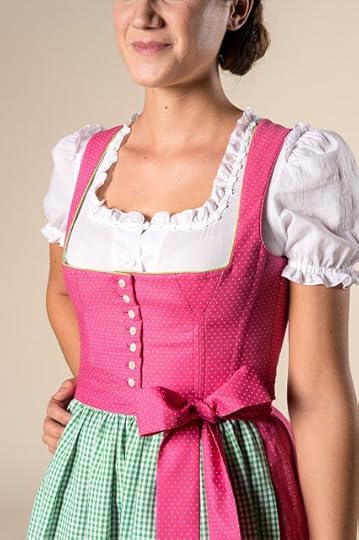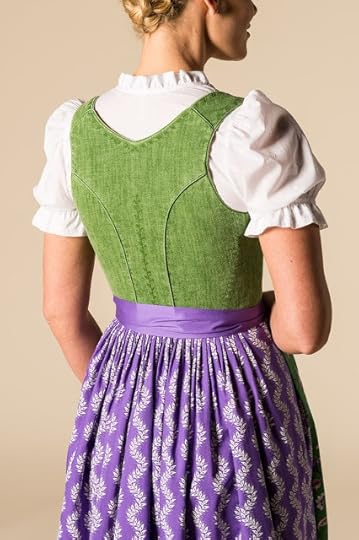Dirndls and Boning
 Lodenfrey Dirndl, which uses boning at center front, concealing the hook and eye closureI've always loved the subject of adding structure to fitted vintage-style dresses. Boning, padding, underwires, underlining, interfacing, interlining: no topic is too minuscule or technical for me to obsess over! So when I caught Dirndl Fever in Germany recently, one of my first questions was about dirndls and boning. Since dirndl bodices are so fitted, it seems like using boning would be a common technique. However, I was surprised to find that the Hammerschmid dirndl I purchased in Passau has no boning in the bodice (though the entire outer layer is interfaced with what appears to be fusible Weft interfacing).
Lodenfrey Dirndl, which uses boning at center front, concealing the hook and eye closureI've always loved the subject of adding structure to fitted vintage-style dresses. Boning, padding, underwires, underlining, interfacing, interlining: no topic is too minuscule or technical for me to obsess over! So when I caught Dirndl Fever in Germany recently, one of my first questions was about dirndls and boning. Since dirndl bodices are so fitted, it seems like using boning would be a common technique. However, I was surprised to find that the Hammerschmid dirndl I purchased in Passau has no boning in the bodice (though the entire outer layer is interfaced with what appears to be fusible Weft interfacing).After buying my dirndl, I shopped again in a couple dirndl shops in Rothenburg specifically looking at the structure of the bodices. Evidence of boning was found! A few of the dirndls in the Pollinger shop had just two rows of boning, one on either side of the front zipper opening. The closest example I could find online was this Lodenfrey dirndl on eBay. See how there's a centered zipper with topstitching, and then two more rows of topstitching to either side of the zipper? The bones are inserted into the channels formed by the topstitching.
 SourceThis center front boning placement seems fairly common, and would be especially helpful if you were concerned about keeping the front opening of your dirndl sturdy and wrinkle-free (functioning like a busk on a corset). A few resources on this type of boning placement:
SourceThis center front boning placement seems fairly common, and would be especially helpful if you were concerned about keeping the front opening of your dirndl sturdy and wrinkle-free (functioning like a busk on a corset). A few resources on this type of boning placement:Here's a video on adding boning in the lining and at center front (though I would personally like to find a way to do this that hides the zipper tape between the outer fabric and the lining).Some very skillful dirndl sewing from a blogger, with incorporated center front boning. This Folkwear pattern incorporates optional center front boning.
I was curious if there were other ways of placing boning in a dirndl. Some more obsessive web searching brought me to Gössl, a traditional Austrian design house that seems to use boning much more liberally in their dirndl bodices. Bingo! Check out these photos.
 Source You can see a boning channel underneath the bust and then one that extends diagonally from the underarm to the waist.
Source You can see a boning channel underneath the bust and then one that extends diagonally from the underarm to the waist. SourceThese dirndls also have a line of boning on the back bodice. The back boning extends from the underarm to the waistline, near the side seam.
SourceThese dirndls also have a line of boning on the back bodice. The back boning extends from the underarm to the waistline, near the side seam. SourceIn these cases, it's interesting how the bones appear to be inserted into a stitched channel between the outer bodice and the lining, much like a corset.
SourceIn these cases, it's interesting how the bones appear to be inserted into a stitched channel between the outer bodice and the lining, much like a corset.On a side note, I went down some interesting rabbit holes with Google Translate. Gössl refers to their boning as miederstäbe, which translated back to me as "bodice rods." Lodenfrey uses the term formstäbchen, which Google translated as "shape chopsticks." Shape chopsticks! I love that! (On a side note to my side note, I obviously need to learn German if I'm going to really sew some dirndls.)
So readers, this is just a collection of my initial research into the use of boning in dirndls. All this said, it's also very common for dirndls not to use boning at all. I wrote to the kind ladies at Limberry (a site that carries some rather high-end designer dirndls), and they quickly wrote back saying the only designer they carry who uses boning in her dirndls is Sonia Fellner, whose designs incorporate a lot of corseting details.
 Sonja Fellner dirndl
Sonja Fellner dirndlNow, I know I'm not the only one out there who's spent time pondering this very subject. I would love to hear your experiences and thoughts on the matter of dirndls and boning, readers!
Published on September 16, 2015 11:18
No comments have been added yet.
Gretchen Hirsch's Blog
- Gretchen Hirsch's profile
- 49 followers
Gretchen Hirsch isn't a Goodreads Author
(yet),
but they
do have a blog,
so here are some recent posts imported from
their feed.



